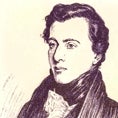

Sections
Highlight

ALEKK M. SAANDERS
Friday, 8 April 2022, 13:44
The 8 April is marked as the International Romany (Gypsy) Day. It was officially declared in 1990 in honour of the first major international meeting of Romany representatives, 7–12 April 1971, in Chelsfield near London. The holiday is aimed to celebrate Romany culture and raise awareness of the issues facing Romany people. The most important contribution to Romany culture was made by George Borrow. He wrote novels and travelogues based on his travels around Europe, particularly to Spain and Andalucía where he developed a close relationship with local Gypsies as well as a lifelong empathy with their music, dance and customs. Borrow also translated the Gospel of St Luke into the Romany language.
George Borrow was born in East Dereham, Norfolk in 1803 to an army recruiting officer and farmer's daughter. He finished the Royal High School of Edinburgh and later was educated at Norwich Grammar School. Incidentally grammar, languages and literature were his favourite subjects. First he learned to read Latin and Greek as well as some Gaelic and even Welsh. Borrow's precocious linguistic skills also allowed him to acquire a working knowledge of Danish and Russian as well as the Romany and Basque languages taught to him in Spain.

It is believed that his contact with Gypsies began in Russia. During his Bible Society expedition there, Borrow met the Russian poet Alexander Pushkin who also admired the Romany people and who apparently advised him to visit the Russian Gypsies, camped on the outskirts of Moscow. His impressions of this encounter and his later Spanish experiences, were written in his first book.
George Borrow was sent to Spain by the British and Foreign Bible Society after a stay in Portugal. On 11 November 1835, the writer first stopped in Badajoz, where he apparently made contact with Spanish Gypsies. On 26 January 1836, Borrow arrived in Madrid where he lived until 1840. “The huge population of Madrid, with the exception of a sprinkling of foreigners... is strictly Spanish, though a considerable portion are not natives of the place. Here are no colonies of Germans as at Saint Petersburg; no English factories as at Lisbon; no multitudes of insolent Yankees lounging through the streets as at the Havannah...,” so George Borrow described the Spanish capital.
Andalucía was next in Borrow's sights, thanks to its numerous Gypsy population. His first visit to Andalucía was made in 1836. It was a long journey with him staying in Jaen and Granada. In Granada, he encountered a lot of artistic Gypsies who had been living in the caves in the Sacromonte neighbourhood since the Reconquista and the expulsion of the Moors.
Borrow spoke the Romany language, called el calí or caló, fluently. So they soon found a mutual understanding and confidence. It appears the Englishman was often considered a part of their wider community and the local Gypsies even called him 'the London Caloro', meaning 'one of the blood', i.e. a Gypsy. In the Sacromonte caves he fell in love with flamenco that for him was synonymous to Gypsies. In his book The Zincali: An Account of the Gypsies of Spain, first published in 1841 he comments: "'gitanos' ('Gypsies' in Spanish)...are also known as 'castellanos nuevos', 'germanos' and 'flamencos'”.
In 1851, he finished Lavengro – a mixture of two genres, a memoir and a novel. At various points through the book, the main character George associates with Romany travellers, of whom he made memorable and generally sympathetic, pen-portraits. Later, Lavengro was followed by a sequel, The Romany Rye. Though in the beginning Lavengro wasn't an immediate success but now it is considered a classic of 19th-century English literature
It is thought George Borrow travelled across the whole of Andalucía and even dropped in on Gibraltar. Borrow's reminiscences of Andalucía became the basis of his travelogue The Bible in Spain. The author managed to visit Cadiz and Seville, then headed eastwards to the Sierra Morena in Jaen with stops in Cordoba and Andújar, Tarifa and Algeciras, Sanlúcar, Écija, and Carmona. Some episodes are featured with Borrow's anecdotes. However, in spite of any unpleasant stereotypes of Gypsies at that time, George Borrow respected them highly. The Englishman became integrated into the Gypsy community in Andalucía.
George Borrow left Spain for London on board the steam packet Royal Adelaide on 16 April 1840 never to return. He died in 1881. In December 2011 a plaque to him was unveiled on number 16, Calle Santiago, Madrid, the house where the English writer lived from 1836 to 1840.
Publicidad
Publicidad
Publicidad
Publicidad
Esta funcionalidad es exclusiva para registrados.
Reporta un error en esta noticia

Debido a un error no hemos podido dar de alta tu suscripción.
Por favor, ponte en contacto con Atención al Cliente.

¡Bienvenido a SURINENGLISH!

Tu suscripción con Google se ha realizado correctamente, pero ya tenías otra suscripción activa en SURINENGLISH.
Déjanos tus datos y nos pondremos en contacto contigo para analizar tu caso

¡Tu suscripción con Google se ha realizado correctamente!
La compra se ha asociado al siguiente email
Comentar es una ventaja exclusiva para registrados
¿Ya eres registrado?
Inicia sesiónNecesitas ser suscriptor para poder votar.